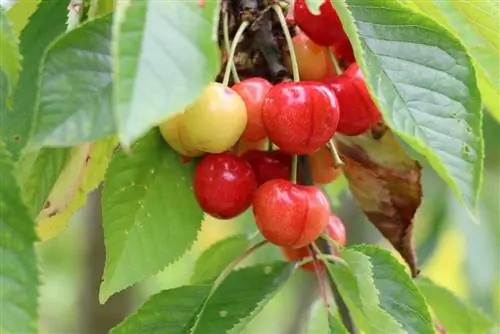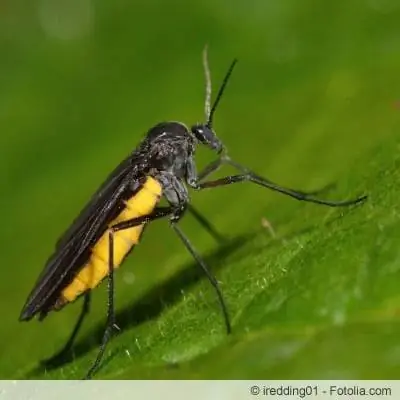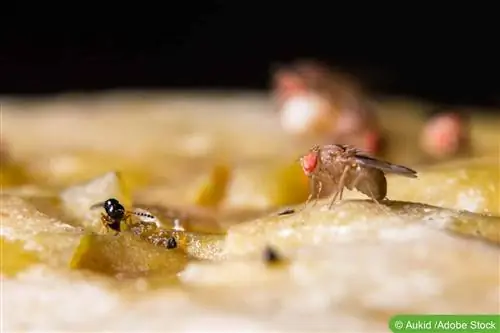- Author admin [email protected].
- Public 2023-12-17 03:39.
- Last modified 2025-01-24 12:45.
The blackfly is relatively unknown and often goes unnoticed due to its small size. However, the bites of these animals, which are just a few millimeters in size, are not always harmless. Even if black flies are not yet considered disease vectors in Central Europe, the number of inflammations and allergic reactions requiring treatment is still increasing. However, with preventative measures and the right treatment, the risk of blackfly bites can be reduced.
Recognize
There are over 50 species of black flies in Germany alone. There are more than 2,000 species worldwide. In almost all of these species, the females are so-called obligate bloodsuckers, with the majority of their diet consisting of flower nectar and not the blood of hosts. Recognizing black flies is often not easy because the insects are very small. They are just two to six millimeters long.
The body structure is reminiscent of that of flies, with the rear section of the body appearing bulbous and stocky. An aid to identification is their appearance in swarms, although this only occurs for the purpose of finding a partner. The swarms can be found near dark objects and backgrounds.
Occurrences
Since black flies lay their eggs exclusively on or in flowing water, the insects are mainly found near them. However, a natural flow is not necessary for this. A stream in the garden can also be used to lay eggs.
In addition, black flies are increasingly found in areas with herds of cattle and horses, as the female insects also use these as hosts. The danger is particularly high near rivers and in rural areas with pastures.
Tip:
Caution should be exercised when black flies appear near livestock and horses. When the insects bite, they often try to escape the trigger due to pain and itching and then sometimes run “blindly” into obstacles.
Bite or sting?
Black flies are often referred to as bites, but strictly speaking they are bites that are then sucked out. We are talking about so-called pool feeders or pool vacuum cleaners. The mosquitoes scratch the skin so that blood and lymph collect in it.
The escaping fluids are sucked up by the black flies with a proboscis, and blood thinners are also injected by the biting mosquitoes so that the fluids come out more intensively. Through the injury in the skin and the injected substance, germs can penetrate and pathogens can be transmitted, which in turn can trigger inflammation and infections.
Detecting bites
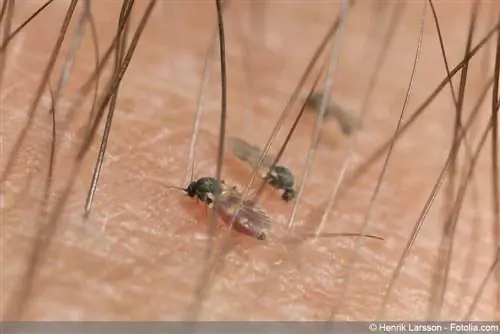
The blackfly bite initially seems quite inconspicuous. Although there is itching and swelling, these signs initially differ little from the bite of a “normal” mosquito, i.e. the mosquito.
However, the difference becomes apparent later. Due to the blood-thinning substances, bleeding into the skin often occurs, i.e. bruising around the bite. In addition, fluid collects in the tissue, which sometimes leads to severe swelling and edema. The affected area around the bite can be several centimeters in size. Despite a small skin injury, the effects are relatively severe. There is usually also pain.
The symptoms are particularly noticeable if there have been several blackfly bites or if there is already an increased sensitivity to insect bites and stings.
Treat bite
We recommend the following to treat black fly bites:
- Rinse with clean water and disinfect with wound treatment
- Continued cooling
- If necessary, antihistamines for allergic reactions
- Cortisone cream for the treatment of inflammation and swelling
If there have been several bites from the black fly or if a strong allergic reaction occurs, you should consult a doctor immediately or alert yourself. This also applies if a fever occurs as a result of a bite. Caution is also advised, especially with children and the following symptoms:
- Headache
- Dizziness
- Nausea
- Fatigue
- Severe pain
- Severe swelling
- Difficulty breathing
The symptoms can be indications of serious allergic reactions, pseudo-allergic reactions or even blood poisoning.
He alth Danger
The black fly injects blood thinners into its host's wound, but can also transmit pathogens during the sucking process. Although transmission is unlikely in this country, it is possible due to changes in the climate. In doctor's offices it is already noticeable that the number of complaints caused by blackfly bites is increasing. A possible explanation for this is the immigration of mosquito species from southeastern Europe.
Another potential danger is bacterial infections. Although these are also rather rare, they should be treated as mentioned. The most common and in rare cases life-threatening are (pseudo-)allergic reactions to the bites. Since the blackfly also injects histamine into the wound, swelling and edema are triggered. If there are a lot of bites and sensitive people, this can lead to severe allergic reactions and even anaphylactic shock.
Prevention
Even though blackfly bites can be very itchy and painful, the bite has an advantage over the bites of other mosquito species. In contrast to mosquitoes with a proboscis, the biting tools do not penetrate clothing. Even a thin layer of fabric on the skin can prevent bites.
If you often travel in areas where there are many swarms of black flies, you should prefer long clothing and stay covered as much as possible.
A repellent can also be used to prevent bites. Preparations containing DEET and Icaridin have proven to be particularly effective, provided they are refreshed regularly.
Home remedies and herbal repellents
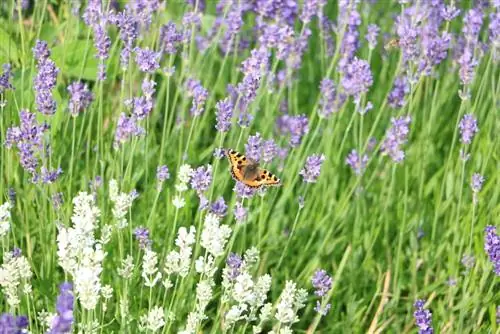
Essential oils such as eucalyptus, citrus and lavender can be used as a defense and thus to prevent blackfly bites. Although they are not quite as effective on the skin as repellents with icaridin or DEET, they can also be distributed in the environment.
For example as:
- Scented candles
- Wet wipes soaked in the essential oil
- As plants in the garden or on the balcony
If a blackfly bite occurs, home remedies can help. For example, the products that are also used for insect bites. Below:
- A sliced onion rubbed over the bite
- A halved clove of garlic, the juice of which is applied
- Lemon juice on the bite
- A mixture of one part water and one part vinegar as a poultice
The home remedies relieve itching, have a cooling effect, can also inhibit inflammation and are available in almost every household. This means they can be used as first aid if neither wound disinfection nor cortisone ointment is immediately at hand. A very simple and helpful home remedy already mentioned is cooling. Cold pads, cold water or ice as well as cooling compresses can be used.
Mechanical protection
If you live near running water or have a stream in your garden, you can and should protect yourself from black flies in other ways besides clothing. Although the insects rarely get lost in apartments, insect protection nets on the windows and doors are useful to keep the flying parasites away.
Tip:
Mosquito nets can help on outdoor seating or terraces.
Conclusion
Blackfly bites are painful and can cause discomfort for days. However, the right measures and remedies can prevent them and effectively relieve pain, swelling and itching. However, they should not be taken lightly.


